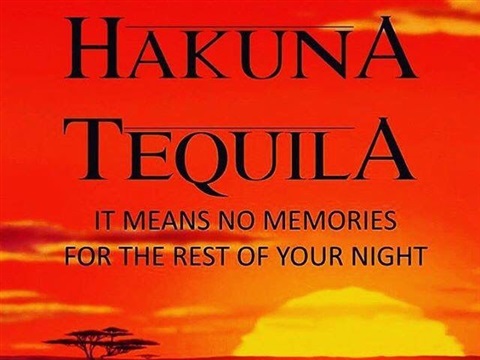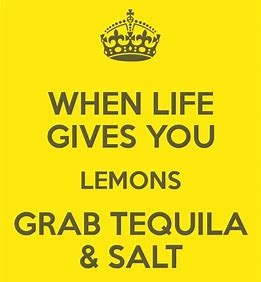DONT BE TOO QUICK TO SLAM & SHOT THAT TEQUILA DOOR!
July 24th is National Tequila Day.
To honour this joyous occasion, it’s time to get gemmed up and appreciate this unusual and sometimes misunderstood drink!
Often, after the first tequila, you’re on a roll shot after shot; sucking limes, licking salt and the process is repeated until your legs turn to jelly and your memory turns blank in the way it would do if you were hit in the back of the head by a shovel! When you wake up the following morning fully clothed, lying face down in the running position you swear you and Tequila will never meet again and wonder who kept hitting you with that damn shovel as your head is still thumping!
Tequila drives you crazy! Or does it?
In actual fact mood dictates your drink more than drink dictates your mood.
So, the next time someone blames their crazy behaviour on tequila, stop and realise that's exactly how they wanted to be.
But you don’t have to cross it off your alcoholic beverage list for good - just do it right!
❤Did you know that the blue agave plants, the main ingredient in tequila, are hand tended and take seven to ten years to grow to maturity? ❤
Appreciate these years of love put into tequila—which is why you should shoot it in a way that shows understands that love.
👍Tequila should be enjoyed neat, at room temperature where you’ll experience a lot more of the drink’s flavours so ditch any chilling and forget all the lime-and-salt theatrics.
👍Good quality tequila deserves to be sipped, never knocked back with a chaser.
- Tequila was first produced in the 16th century near the location of the city of Tequila, which was not officially established until 1656.
- It is made by steaming the hearts of the blue agave plant, one of approximately 136 species of agave grown in Mexico.
- Once steamed, the hearts are minced to a pulp, combined with water, and fermented, producing an alcoholic liquid that's then distilled and bottled.
- The blue agave is a spiky Mexican plant which resembles a cactus and the core of the plant contains aguamiel or “honey water,” which is used for syrup (and tequila) production.
- Blue agave grows primarily in the area surrounding the city of Tequila, 65 kilometres (40 mi) northwest of Guadalajara, and in the highlands (Los Altos) of the central western Mexican state of Jalisco.
- It takes blue agave about 8 years to reach maturity sufficient enough to be harvested and distilled into tequila.
- In the Jalisco state of Mexico, home many of the largest tequila distilleries, tequila is often followed by a chaser of sangrita or a "little blood", made of a blend of tomato and orange juice with chili powder.
- Tequila is mezcal, but mezcal is not tequila! Yes, you read that correctly!
- Mezcal is a liquor made from the maguey plant, a form of agave. And can be made using a variety of agave plants, but tequila must be made using only blue agave.
- Premium tequila will aim for 40% alcohol per volume (80 proof); lower quality spirit instead aims for 55% alcohol per volume (110 proof), which will be later diluted with purified water.
- The main types of tequila are split into two categories: 100% Blue Agave, and Tequila Mixto (Mixed). These, in turn, are then divided into five types of Tequila: Tequila Silver - Blanco - Plata - White – Platinum; Tequila Gold - Joven – Oro; Tequila Reposado; Tequila Añejo (extra aged); and Tequila Extra Añejo (extra, extra aged).
- Both Reposado and Anejo are excellent substitutes for rum, bourbon or scotch and cognac or Armagnac.
- Each type is dependent on how long the spirit sits before it’s bottled, as well as what container it’s kept in. For example, blanco tequilas are aged up to two months in stainless steel containers while reposado (rested) and añejo (aged) tequila must be matured in 200-liter (or larger) oak barrels for at least 2 months for the first, and 12 months for the last.
- Tequila comes in an abundant array of colours that ranges from a simple clear distilled beverage to a dark amber brown. The colour of the tequila varies greatly on the aging process and the type of wood used for storage.
- A bottle of tequila can last unopened for years. However, once you open a bottle, you have about one to two months before oxidisation and evaporation lower the quality of the tequila and destroys the agave profile.
- So, you want to drink up within 3 to 6 months, at which point it becomes more like a bourbon.
👎You shouldn’t store tequila in sunlight. If you’re not planning on throwing back an entire bottle of tequila in one night (which, please don’t), it’s a good idea to store opened bottles in a cabinet or anywhere that's not in direct sunlight. If you don’t expose the bottle to the sun, it will last a year If you do let it sit in the sun the alcohol will begin to evaporate, and the flavour will suffer. Even one or two days in the sun will affect the tequila's taste.
- Tequila must be produced in Mexico: Just like bubbly must come from the Champagne wine region of France in order to officially be called champagne, tequila must be produced in specific areas of Mexico.
- Any type of “tequila” made outside these regions is merely called an agave spirit.
- According to The Guinness Book of World Records, the most expensive bottle of tequila ever sold went to a private collector for $225,000. The bottle was made out of white gold and platinum and contained six year-aged tequila worth $2,500.
👍Real tequila doesn’t have a worm in it. Perhaps even more popular than the actual tequila isthe worm crawling around the bottom of the bottle. But the worm, or gusano, actually originated with tequila’s “lower-quality” cousin, mezcal, largely as a marketing ploy. The gusano is the larvae of a type of moth that lives on the agave plant.
👍Tequila has health benefits: Studies have shown that a component in tequila helps break down dietary fat, which can lower the levels of bad cholesterol. A shot taken after dinner can aid your body’s digestion.
👍High-quality tequila is properly distilled and won’t give you a headache! The distilling process for well-made tequila, is controlled to eliminate components that might cause headaches.
- The 1918 flu epidemic led to a tequila boom in Mexico as doctors advised ailing patients to drink tequila, lime, and salt as a remedy.
- The machete used to chop agave leaves is called a Coa and has circular blades. And the men who use the Coa are called Jimadors.
- Some premium tequilas, such as Patrón, use the “Tahona” process in which a 2-ton volcanic stone wheel slowly crushes the shredded, cooked agave. The agave juice and fibres are then placed in pine wood casks for fermentation. During the next step, distillation, the fermented "mosto" (or basic liquid) is distilled once with the agave fibre, then again without. Then it is fine filtered and balanced to produce tequila. At Patrón, more than 60 hands will touch a single bottle before it is shipped.
- You can make synthetic diamonds with tequila: Physicists from the National Autonomous University of Mexico figured out a way to make faux diamonds using tequita. The crystals are too small to be made into jewellery, but they can be used in other industrial ways such as an alternative to silicon in computer chips.
👍A variety of cocktails are made with tequila, including the Margarita, Tequila Sunrise, Juan Collins, Tequini, Brave Bull, Matador, Envy Cocktail, Tequila Slammer, Toronha, and Passion Cocktail or why not try a Jalisco Mule for which is similar to a Moscow mule — a cocktail made with vodka, spicy ginger beer, and lime juice.
👍Making a great tequila takes seven years... Drinking a great tequila shouldn’t take seven minutes!



